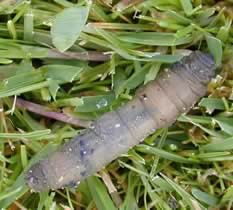05/02/08
Leatherjacket population levels in Scotland have crashed this
winter from the extremely high levels recorded over the past four
years. According to the findings of the annual survey carried out
by SAC, the average population density of 0.32 million grubs per
hectare is the fourth lowest recorded since the survey started
over 30 years ago.
The risk of leatherjacket damage to fields remaining as
permanent grassland is very low this year across all of
the areas surveyed in south-west and central Scotland.
However, over one-fifth of the 221 fields’ sampled
contained populations greater than 0.6 million grubs per
ha. Hence, there still remains a risk of damage to any
spring crops sown into grassland fields which are currently
harbouring grubs.
The degree of risk to spring-sown crops after grass varies
from area to area. The risk is particularly high in Argyll,
Bute, Renfrew and Wigtownshire and also relatively high
in Ayrshire, Lanarkshire and Stirling/Perth. Only in Dumfries/Kirkcudbright
does the risk appear low. Surveyed grub population levels
in Stirling/Perth can be taken as a good indication of
likely grub levels in non-surveyed areas (such as north-east
and south-east Scotland) where ley-grassland is also a
more common feature of the farmed landscape. Hence it is
likely that the risk of damage to spring-sown crops after
grass is also relatively high in the north-east and south-east
this year.
The survey has been undertaken by SAC ecologist Dr Davy
McCracken who advises farmers against insurance spraying:
“Despite this potential grub threat to spring crops
out of grass, it is important that an assessment of leatherjacket
infestation is conducted prior to the application of any
insecticide treatment. Conducting such assessments now
helps identify those fields at risk before any damage,
and associated loss of productivity, has occurred. This
allows any necessary control measures to be targeted cost-effectively.”
“It makes sense, for both economic and environmental
reasons, that any insecticide application should be restricted
to only those fields where the need has been demonstrated”.
SAC crop protection specialists advise that if leatherjacket
infestations are found to be high, an insecticide should
be applied as soon as ground conditions permit. When planning
to sow spring crops after grass, insecticide treatment
of the grass before ploughing will knock leatherjacket
numbers back sufficiently to give the crop a good start.
However, where grub densities prior to arable crops are
marginal for treatment, current advice is not to take preventative
action against the grub straight away but to wait and monitor
the emerging crops and treat only if necessary.
 NK Bull: Highest Yielding Maize Variety on 2008 Descriptive List NK Bull: Highest Yielding Maize Variety on 2008 Descriptive List
 The
UK Pesticide Guide 2008 - Celebrates 21 Years of Publication The
UK Pesticide Guide 2008 - Celebrates 21 Years of Publication
 High Yielding Varieties Extend BSH Forage Maize Range High Yielding Varieties Extend BSH Forage Maize Range |


